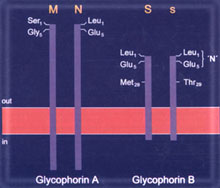

 Blood Group System - MNS
Blood Group System - MNSAbbreviation - MNS ISBT Number - 002 MNS was the second blood group system to be discovered (1927). In a deliberate attempt to discover more blood group antigens, Landsteiner and Levine immunized rabbits with human red blood cells. The discovery and elucidation of inheritance was one of the most brilliant achievements in this field of biology; out of forty-one sera four were found to have a distinctive agglutinin that reacted independent of the then know ABO blood group types. By selective immunization and absorption, the serological specificities and inheritance of M and N were described. It was twenty years before the third antigen of the group, S, was identified; followed shortly by the discovery of the product of its antithetical allele, s. Because of this system's usefulness in testing inheritance within pedigrees, several newly discovered blood group antigens were found to be associated with this system; some being high incidence antigens (i.e. U, Ena) or, more frequently, low incidence antigens (i.e. Mg, He, Mta, etc). To date there have been over 43 antigens associated with this blood group system. The MNS antigens are located on either glycophorin A, glycophorin B, hybrid or mutant structures of both of these sialoglycoproteins which are encoded by two highly homologous and closely linked genes on the long arm of chromosome 4. This system was the first non-water soluble blood group system to be biochemically investigated. Many of the low incidence antigens associated with hybrid structures could only have been assigned to this system through biochemical and DNA investigation. The MNS antigens are found predominately on the red cells with some found on the renal endothelium and epithelium. Antibodies against M are fairly common, being the most frequently found antibody in non-transfused children, however antibodies against N are exceedingly rare (undoubtedly because N can be encoded by some forms of glycophorin A when the N gene is present and the most common form of glycophorin B). Even though anti–M antibodies are found in multiply transfused individuals and multiparous females, it rarely if ever is associated with hemolysis of red cells. Antibodies against S, s and the majority of the remaining high and low incidence MNS antigens have been associated with hemolytic transfusion reactions and hemolytic disease of the newborn. As with most blood group systems, this system has its "null" individuals. Those that lack both glycophorin A and B are referred to as MkMk (there are no detectable MNS antigens on these individuals' red cells). Those that lack glycophorin A but have a normal glycophorin B are En(a-) individuals and those that have glycophorin A but lack glycophorin B are S-s-U- individuals. Interestingly, Landsteiner and Levine’s discovery prompted them to test apes with antisera prepared by immunizing rabbits with human M blood. These studies led them, conversely, to immunized rabbits with rhesus monkey blood in order to prepare anti-M reagents. Refer to the Rh blood group system and LW blood group system for their discovery. |

